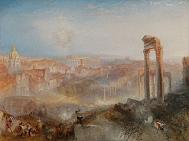 |
 |
 |
 |
Grades/Level: High School (9–12)
Subjects: Visual Arts, English–Language Arts, History–Social Science
Time Required: 3–5–Part Lesson
Two to three class periods
Author: J. Paul Getty Museum Education Staff
Permissions: 
The lesson plan and downloadable materials on this page are licensed under a Creative Commons Attribution 4.0 International License. |
 |
|
 |
 |
 |
 |
 |
 |
 |
Lesson Overview |
 |
Students will examine architectural structures in paintings and how they are used, also considering the art elements, composition, emphasis, color, and light. They will also study the relationship between the built environment and nature in the paintings. Students then complete activities in which they select words and phrases to describe a painting's mood and write related poetry. Then they create drawings and write related poetry. As an optional activity, students may construct their own camera obscura and create a drawing. |
 |
 |
 |
 |
 |
Learning Objectives |
 |
Students will be able to:
• examine the use of architectural structures in paintings.
• consider the use of composition, emphasis, color, and light in paintings.
• write words, phrases, and a stanza of a poem depicting a painting's mood.
• draw an interior and write a related stanza of a poem.
• draw exterior landmarks and write a related stanza of a poem.
|
 |
 |
 |
 |
 |
 |
 |
 |
 |
Materials |
 |
• Reproduction of The Interior of St. Bavo, Haarlem by Pieter Jansz. Saenredam
• Reproduction of Modern Rome—Camp Vaccino by Joseph Mallord William Turner
• Reproduction of A View of the Bay of Naples by Giovanni Battista Lusieri
• Background Information and Questions for Teaching about The Interior of St. Bavo, Haarlem
• Background Information and Questions for Teaching about Modern Rome—Camp Vaccino
• Background Information and Questions for Teaching about A View of the Bay of Naples
• Student Handout: "Elements of Art"
• Student Handout: "Principles of Design"
• Student Handout: "Architecture Vocabulary"
• Pencils and/or pens
• Student Handout: "The Poetry of Architecture: Fact Meets Fiction"
• Student Handout: "The Poetry of Architecture: Make It Romantic"
• Art Activity: "Create a Camera Obscura" (optional extension) |
 |
 |
 |
 |
 |
|
|
 |
 |
 |
 |
 |
Lesson Steps |
 |
1. Show students the reproduction of The Interior of St. Bavo, Haarlem by Pieter Jansz. Saenredam.
2. Pass out copies of the "Elements of Art" handout, the "Principles of Design" handout, and the "Architecture Vocabulary" handout for reference.
Note: Words in bold on this page and/or handouts are defined in the "Elements of Art," "Principles of Design," and/or "Architecture Vocabulary" handouts for this curriculum. (Also see the links listed in the "Art & Architecture Contents" menu above.)
3. Have a class discussion, prompting students with the questions from the Background Information and Questions for Teaching about The Interior of St. Bavo, Haarlem.
4. Show students the reproduction of Modern Rome—Camp Vaccino by Joseph Mallord William Turner.
5. Have a class discussion, prompting students with the questions from the Background Information and Questions for Teaching about Modern Rome—Camp Vaccino.
6. Show students the reproduction of A View of the Bay of Naples by Giovanni Battista Lusieri.
7. Have a class discussion, prompting students with the questions from the Background Information and Questions for Teaching about A View of the Bay of Naples.
8. Pass out copies of the student handout "The Poetry of Architecture: Fact Meets Fiction," along with pencils and/or pens.
9. Tell students to follow the step-by-step instructions on the student handout "The Poetry of Architecture: Fact Meets Fiction" to complete the activity.
10. Pass out copies of the student handout "The Poetry of Architecture: Make It Romantic" to the class.
11. Tell students to follow the step-by-step instructions on the student handout "The Poetry of Architecture: Make It Romantic" to complete the activity. Have students work in pairs to do most of the activity.
|
 |
 |
 |
| Modern Rome—Camp Vaccino, Joseph Mallord William Turner, 1839 |
 |
|
 |
 |
 |
 |
 |
 |
 |
Assessment |
 |
Students will be assessed on their
• understanding of the use of architectural structures in paintings.
• understanding of the use of composition, emphasis, color, and light in paintings.
• written words, phrases, and stanza of a poem depicting a painting's mood.
• drawing of an interior and related written stanza of a poem.
• drawing of exterior landmarks and related written stanza of a poem.
|
 |
 |
 |
 |
 |
Extensions |
 |
• Have students make their own camera obscura, much like the one used by Giovanni Battista Lusieri as a tool for designing and creating works of art such as his watercolor A View of the Bay of Naples. Download, copy, and pass out the art activity "Create a Camera Obscura." See the materials list on the activity for all tools and materials needed. Guide students as they follow the steps on the activity to create their own camera obscura. You may wish to model this activity as students do this project.
• Have students use their camera obscura to draw a cityscape.
|
 |
 |
 |
 |
 |
 |
 |
 |
 |
Standards Addressed |
 |
Common Core Standards for English Language Arts
Grades 9–12
WRITING
Production and Distribution of Writing
4. Produce clear and coherent writing in which the development, organization, and style are appropriate to task, purpose, and audience.
SPEAKING AND LISTENING
Comprehension and Collaboration
1. Prepare for and participate effectively in a range of conversations and collaborations with diverse partners, building on others' ideas and expressing their own clearly and persuasively.
2. Integrate and evaluate information presented in diverse media and formats, including visually, quantitatively, and orally.
|
 |

|
 |
 |
 |






